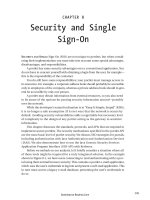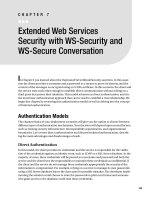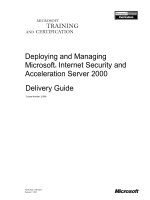LESSON 10: WEB SECURITY AND PRIVACY
Bạn đang xem bản rút gọn của tài liệu. Xem và tải ngay bản đầy đủ của tài liệu tại đây (727.09 KB, 24 trang )
LESSON 10
WEB SECURITY AND
PRIVACY
“License for Use” Information
The following lessons and workbooks are open and publicly available under the following
terms and conditions of ISECOM:
All works in the Hacker Highschool project are provided for non-commercial use with
elementary school students, junior high school students, and high school students whether in a
public institution, private institution, or a part of home-schooling. These materials may not be
reproduced for sale in any form. The provision of any class, course, training, or camp with
these materials for which a fee is charged is expressly forbidden without a license including
college classes, university classes, trade-school classes, summer or computer camps, and
similar. To purchase a license, visit the LICENSE section of the Hacker Highschool web page at
www.hackerhighschool.org/license.
The HHS Project is a learning tool and as with any learning tool, the instruction is the influence
of the instructor and not the tool. ISECOM cannot accept responsibility for how any
information herein is applied or abused.
The HHS Project is an open community effort and if you find value in this project, we do ask
you support us through the purchase of a license, a donation, or sponsorship.
All works copyright ISECOM, 2004.
2
LESSON 10 – WEB SECURITY AND PRIVACY
Table of Contents
“License for Use” Information............................................................................................................... 1
Contributors..............................................................................................................................................1
10.1 Fundamentals of Web Security..................................................................................................... 1
10.1.1 How the web really works.......................................................................................................1
10.1.2 Rattling the Locks....................................................................................................................1
10.1.3 Looking through Tinted Windows - SSL................................................................................. 1
10.1.4 Having someone else do it for you – Proxies....................................................................... 1
10.2 Web Vulnerabilities..........................................................................................................................1
10.2.1 Scripting Languages................................................................................................................1
10.2.2 Common Web Application Problems...................................................................................1
10.2.3 Guidelines for Building Secure Web Applications................................................................1
10.3 HTML Basics – A brief introduction................................................................................................1
10.3.1 Reading HTML...........................................................................................................................1
10.3.2 Viewing HTML at its Source.....................................................................................................1
10.3.3 Links ..........................................................................................................................................1
10.3.4 Proxy methods for Web Application Manipulation............................................................. 1
10.4 Protecting your server.....................................................................................................................1
10.4.1 Firewall.......................................................................................................................................1
10.4.2 Intrusion Detection System (IDS).............................................................................................1
10.5 Secure Communications................................................................................................................1
10.5.1 Privacy and Confidentiality....................................................................................................1
10.5.2 Knowing if you are communicating securely......................................................................1
10.6 Methods of Verification.................................................................................................................1
10.6.1 OSSTMM.....................................................................................................................................1
Exercises...............................................................................................................................................1
Further Reading.......................................................................................................................................1
3
LESSON 10 – WEB SECURITY AND PRIVACY
Contributors
Simon Biles
Pete Herzog, ISECOM
Bill Matthews
Hernán Marcelo Racciatti
Chris Ramirez
P. Shreekanth
Kim Truett , ISECOM
Marta Barceló, ISECOM
Dario Riquelme Zornow
4
LESSON 10 – WEB SECURITY AND PRIVACY
10.1 Fundamentals of Web Security
What you do on the World Wide Web is your business. Or so you would think. But it's just not
true. What you do on the web is about as private and anonymous as where you go when
you leave the house. Again, you would think that it's your business and many, including
ISECOM, would agree with you. However, consider a private investigator following you
around town, writing down what you saw and who you spoke with.
The focus of this lesson is to get you learn how to protect yourself on the web and to do that,
you will have to learn where the dangers are.
The World Wide Web works in a very straight-forward manner. Once connected to the
Internet through you ISP, you open a browser, tell it a website, and you get that website on
your screen. However, the truth is in the details. How does the web really work?
A quick trip to the World Wide Web Consortium (W3C), those fine folks who make standards
for the web, will teach you all you want to know about the web. . Even
the history of the web: The problem is, will definitions and
standards teach you how to be safe? Apparently not. The people who want to hurt you do
not necessarily follow the standards.
10.1.1 How the web really works
The steps involved in connecting to the Internet and then to the web are very detailed even if
it does seem to be smooth from the user end.
So what happens for real when you just want to get to the ISECOM website? Assuming you
are already connected to the internet, here are the steps that occur in order:
1. You open your browser.
2. You type in the URL (website name).
3. Website name saved in History Cache on the hard disk.
4. Your computer looks up the name of the address to your default DNS server to find
the IP address.
5. Your computer connects to the server at the IP address provided at the default
web port of 80 TCP if you used “HTTP://” or 443 TCP if you used “HTTPS://” at the front
of the web server name (by the way, if you used HTTPS then there are other steps
involved using server certificates which we will not follow in this example).
6. Your computer requests the page or directory you specified with the default often
being “index.htm” if you don't specify anything. But the server decides t's default
and not your browser.
7. The pages are stored in a cache on your harddisk. Even if you tell it to store the
information in memory (RAM), there is a good chance it will end up somewhere on
your disk either in a PAGEFILE or in a SWAPFILE.
8. The browser nearly instantaneously shows you what it has stored. Again, there is a
difference between “perceived speed” and “actual speed” of your web surfing
which is actually the difference between how fast something is downloaded
(actual) and how fast your browser and graphics card can render the page and
graphics and show them to you (perceived). Just because you didn't see it doesn't
mean it didn't end up in your browser cache.
5
LESSON 10 – WEB SECURITY AND PRIVACY
The history of the World Wide Web ( just “web” from now on ) started at CERN
1
in 1989. It was
conceived by Tim Berners-Lee and Robert Cailliau who built a basic hypertext based system
for sharing information. Over the next few years Tim Berners-Lee continued to develop the
system until in 1993 CERN announced that the web was free for anyone to use, and the web
as we know it now exploded onto the scene.
The Web is a client and server based concept, with clients such as Internet Explorer, Firefox,
Mozilla, Opera, Netscape and others connecting to web servers such as IIS and Apache
which supply them with content in the form of HTML
2
pages. Many companies, organizations
and individuals have collections of pages hosted on servers delivering a large amount of
information to the world at large.
So why do we care about web security then? Web servers often are the equivalent to the
shop window of a company. It is a place where you advertise and exhibit information, but this
is supposed to be under your control. What you don't want to do is leave the window open so
that any passer by can reach in and take what they want for free, and you ideally want to
make sure that if someone throws a brick, that the window doesn't shatter ! Unfortunately
web servers are complex programs, and as such have a high probability of containing a
number of bugs, and these are exploited by the less scrupulous members of society to get
access to data that they shouldn't be seeing.
And the reverse is true as well. There are risks also associated with the client side of the
equation like your browser. There are a number of vulnerabilities which have been discovered
in the last year which allow for a malicious web site to compromise the security of a client
machine making a connection to them.
10.1.2 Rattling the Locks
Standard HTML pages are transferred using HTTP
3
, this standard TCP based protocol is plain
text based and this means that we can make connections to a server easily using tools such
as “telnet” or “netcat”. We can use this facility to gain a great deal of information about
what software is running on a specific server. For example :
simon@exceat:~> netcat www.computersecurityonline.com 80
HEAD / HTTP/1.0
HTTP/1.1 200 OK
Date: Fri, 07 Jan 2005 10:24:30 GMT
Server: Apache/1.3.27 Ben-SSL/1.48 (Unix) PHP/4.2.3
Last-Modified: Mon, 27 Sep 2004 13:17:54 GMT
ETag: "1f81d-32a-41581302"
Accept-Ranges: bytes
Content-Length: 810
Connection: close
Content-Type: text/html
By entering “HEAD / HTTP/1.0” followed by hitting the “Return” key twice, I can gain all of the
information above about the HTTP Server. Each version and make of HTTP Server will return
different information at this request – an IIS server will return the following :
1 Centre Européen pour la Recherche Nucléaire (European Centre for Nuclear Research)
2 Hyper Text Markup Language
3 Hyper Text Transfer Protocol
6
LESSON 10 – WEB SECURITY AND PRIVACY
simon@exceat:~> netcat www.microsoft.com 80
HEAD / HTTP/1.0
HTTP/1.1 200 OK
Connection: close
Date: Fri, 07 Jan 2005 11:00:45 GMT
Server: Microsoft-IIS/6.0
P3P: CP="ALL IND DSP COR ADM CONo CUR CUSo IVAo IVDo PSA PSD TAI TELo OUR
SAMo CNT COM INT NAV ONL PHY PRE PUR UNI"
X-Powered-By: ASP.NET
X-AspNet-Version: 1.1.4322
Cache-Control: public, max-age=9057
Expires: Fri, 07 Jan 2005 13:31:43 GMT
Last-Modified: Fri, 07 Jan 2005 10:45:03 GMT
Content-Type: text/html
Content-Length: 12934
You can take this further and obtain more information by using the “OPTIONS” request in the
HTTP request as follows :
simon@exceat:~> netcat www.computersecurityonline.com 80
OPTIONS / HTTP/1.0
HTTP/1.1 200 OK
Date: Fri, 07 Jan 2005 10:32:38 GMT
Server: Apache/1.3.27 Ben-SSL/1.48 (Unix) PHP/4.2.3
Content-Length: 0
Allow: GET, HEAD, POST, PUT, DELETE, CONNECT, OPTIONS, PATCH, PROPFIND,
PROPPATCH, MKCOL, COPY, MOVE, LOCK, UNLOCK, TRACE
Connection: close
This will give you all of the allowed HTTP commands that the server will respond to.
Doing all of this by hand is rather tedious, and matching it manually against a database of
know signatures and vulnerabilities is more than anyone would want to do. Fortunately for us,
some very enterprising people have come up with an automated solution called “nikto”.
“Nikto” is a Perl script which carries out various tests automagically ! The options are as follows:
-Cgidirs+ Scan these CGI dirs: 'none', 'all', or a value like '/cgi/'
-cookies print cookies found
-evasion+ ids evasion technique (1-9, see below)
-findonly find http(s) ports only, don't perform a full scan
-Format save file (-o) Format: htm, csv or txt (assumed)
-generic force full (generic) scan
-host+ target host
-id+ host authentication to use, format is userid:password
-mutate+ mutate checks (see below)
-nolookup skip name lookup
-output+ write output to this file
-port+ port to use (default 80)
-root+ prepend root value to all requests, format is /directory
-ssl force ssl mode on port
-timeout timeout (default 10 seconds)
-useproxy use the proxy defined in config.txt
7
LESSON 10 – WEB SECURITY AND PRIVACY
-Version print plugin and database versions
-vhost+ virtual host (for Host header)
(+ means it requires a value)
These options cannot be abbreviated:
-debug debug mode
-dbcheck syntax check scan_database.db and user_scan_database.db
-update update databases and plugins from cirt.net
-verbose verbose mode
IDS Evasion Techniques:
1 Random URI encoding (non-UTF8)
2 Directory self-reference (/./)
3 Premature URL ending
4 Prepend long random string
5 Fake parameter
6 TAB as request spacer
7 Random case sensitivity
8 Use Windows directory separator (\)
9 Session splicing
Mutation Techniques:
1 Test all files with all root directories
2 Guess for password file names
3 Enumerate user names via Apache (/~user type requests)
4 Enumerate user names via cgiwrap (/cgi-bin/cgiwrap/~user type requests)
“Nikto” is quite comprehensive in its reporting as you can see from the following scan :
exceat:/# ./nikto.pl -host www.computersecurityonline.com
---------------------------------------------------------------------------
- Nikto 1.34/1.29 - www.cirt.net
+ Target IP: 217.30.114.2
+ Target Hostname: www.computersecurityonline.com
+ Target Port: 80
+ Start Time: Fri Jan 7 12:23:56 2005
---------------------------------------------------------------------------
- Scan is dependent on "Server" string which can be faked, use -g to override
+ Server: Apache/1.3.27 Ben-SSL/1.48 (Unix) PHP/4.2.3
- Server did not understand HTTP 1.1, switching to HTTP 1.0
+ Server does not respond with '404' for error messages (uses '400').
+ This may increase false-positives.
+ Allowed HTTP Methods: GET, HEAD, POST, PUT, DELETE, CONNECT, OPTIONS, PATCH, PROPFIND,
PROPPATCH, MKCOL, COPY, MOVE, LOCK, UNLOCK, TRACE
+ HTTP method 'PUT' method may allow clients to save files on the web server.
+ HTTP method 'CONNECT' may allow server to proxy client requests.
+ HTTP method 'DELETE' may allow clients to remove files on the web server.
+ HTTP method 'PROPFIND' may indicate DAV/WebDAV is installed. This may be used to get
directory listings if indexing is allowed but a default page exists.
+ HTTP method 'PROPPATCH' may indicate DAV/WebDAV is installed.
+ HTTP method 'TRACE' is typically only used for debugging. It should be disabled.
+ Apache/1.3.27 appears to be outdated (current is at least Apache/2.0.50). Apache 1.3.31 is
still maintained and considered secure.
+ Ben-SSL/1.48 appears to be outdated (current is at least 1.55)
+ PHP/4.2.3 appears to be outdated (current is at least 5.0.1)
+ PHP/4.2.3 - PHP below 4.3.3 may allow local attackers to safe mode and gain access to
unauthorized files. BID-8203.
+ Apache/1.3.27 - Windows and OS/2 version vulnerable to remote exploit. CAN-2003-0460
+ Apache/1.3.27 - Apache 1.3 below 1.3.29 are vulnerable to overflows in mod_rewrite and
mod_cgi. CAN-2003-0542.
+ /~root - Enumeration of users is possible by requesting ~username (responds with Forbidden
for real users, not found for non-existent users) (GET).
+ /icons/ - Directory indexing is enabled, it should only be enabled for specific directories
(if required). If indexing is not used all, the /icons directory should be removed. (GET)
+ / - TRACE option appears to allow XSS or credential theft. See
for details (TRACE)
+ / - TRACK option ('TRACE' alias) appears to allow XSS or credential theft. See
for details (TRACK)
+ /CVS/Entries - CVS Entries file may contain directory listing information. (GET)
8
LESSON 10 – WEB SECURITY AND PRIVACY
+ /images/ - index of image directory available (GET)
+ /manual/ - Web server manual? tsk tsk. (GET)
+ /cgi-bin/cgiwrap - Some versions of cgiwrap allow anyone to execute commands remotely. (GET)
+ /cgi-bin/cgiwrap/~adm - cgiwrap can be used to enumerate user accounts. Recompile cgiwrap
with the '--with-quiet-errors' option to stop user enumeration. (GET)
+ /cgi-bin/cgiwrap/~bin - cgiwrap can be used to enumerate user accounts. Recompile cgiwrap
with the '--with-quiet-errors' option to stop user enumeration. (GET)
+ /cgi-bin/cgiwrap/~daemon - cgiwrap can be used to enumerate user accounts. Recompile cgiwrap
with the '--with-quiet-errors' option to stop user enumeration. (GET)
+ /cgi-bin/cgiwrap/~lp - cgiwrap can be used to enumerate user accounts. Recompile cgiwrap
with the '--with-quiet-errors' option to stop user enumeration. (GET)
+ /cgi-bin/cgiwrap/~root - cgiwrap can be used to enumerate user accounts. Recompile cgiwrap
with the '--with-quiet-errors' option to stop user enumeration. (GET)
+ /cgi-bin/cgiwrap/~xxxxx - Based on error message, cgiwrap can likely be used to find valid
user accounts. Recompile cgiwrap with the '--with-quiet-errors' option to stop user
enumeration. (GET)
+ /cgi-bin/cgiwrap/~root - cgiwrap can be used to enumerate user accounts. Recompile cgiwrap
with the '--with-quiet-errors' option to stop user enumeration. (GET)
+ /css - Redirects to , This might be
interesting...
+ 2449 items checked - 15 item(s) found on remote host(s)
+ End Time: Fri Jan 7 12:25:36 2005 (100 seconds)
---------------------------------------------------------------------------
• 1 host(s) tested
Using the other options you can fine tune Nikto to do exactly what you need to achieve,
including stealth, mutation and cookie detection.
10.1.3 Looking through Tinted Windows - SSL
It wasn't too long before everyone realized that HTTP in plain text wasn't much good for
security. So the next variation was to apply encryption to it. This comes in the form of SSL
4
, and
is a reasonably secure 40 or 128 bit public key encryption method. Using a 40 bit key is a lot
less secure than the 128 bit and, with specialized hardware, may well be brute force
breakable within a period of minutes, where as the 128 bit key will still take longer that the
age of the Universe to break by brute force. There are however more complex technical
attacks using something called a known cyphertext attack – this involved calculating the
encryption key by analyzing a large number of messages ( > 1 million ) to deduce the key. In
any case, you aren't going to be rushing to try and crack 128 bit encryption – so what can we
learn about SSL HTTP Servers?
Quite a lot actually. As the SSL merely encrypts the standard HTTP traffic, if we set up an SSL
tunnel, we can query the server as we did in section 1.1. Creating an SSL tunnel is quite
straight forward, and there is a utility called “stunnel” purely for this purpose. Enter the
following into a file called stunnel.conf, (replacing ssl.enabled.host with the name of the SSL
server that you want to connect to:
client=yes
verify=0
[psuedo-https]
accept = 80
connect = ssl.enabled.host:443
TIMEOUTclose = 0
Stunnel will then map the local port 80 to the remote SSL Port 443 and will pass out plain text,
so you can connect to it using any of the methods listed above :
4 Secure Sockets Layer
9
LESSON 10 – WEB SECURITY AND PRIVACY









